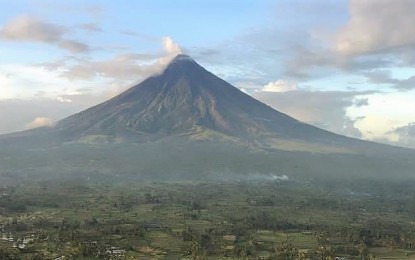
Mayon Volcano in Albay province (PNA file photo)
LEGAZPI CITY – The Philippine Institute of Volcanology and Seismology (Phivolcs) has raised Mayon Volcano's alert status from Level 0 to Level 1.
Level 0 means "normal" while Level 1 signifies "low-level unrest".
Phivolcs said daily visual and camera monitoring of the summit crater revealed that the remnant lava dome emplaced toward the end of the 2018 eruption has undergone a change in morphology and slight extrusion by 40,000 cubic meters between June and Aug. 20, this year.
The agency's bulletin on Sunday said ground deformation observations from Global Positioning Systems (GPS), precise leveling (PL), electronic tilt, and electronic distance meter (EDM) monitoring "have tracked slight short-term inflation of the volcano edifice, particularly on the northwestern and southeastern slopes since April 2022."
"In contrast, the latest measured Sulfur dioxide (SO2) emission on 12 August 2022 averaged 688 t/d, near baseline levels. Short-lived spikes in the number of low-frequency volcanic earthquakes were recorded on 26 May and 20 June 2022, but for most of this year, only baseline seismic activity has been detected. These observation parameters indicate that volcanic gas-induced pressurization at the shallow depths of the edifice may be occurring, causing the summit dome of Mayon to be pushed out," it said. "The Mayon Volcano is exhibiting abnormal conditions and has entered a period of unrest."
Phivolcs said entry into the 6-km Permanent Danger Zone or PDZ must be strictly avoided due to an increase in the chances of sudden steam-driven or phreatic eruption, as well as the perennial hazards of rockfalls, avalanches, and ash bursts at the summit area that may occur without warning.
People living in valleys and active river channels are cautioned to remain vigilant against sediment-laden streamflows and lahars in the event of prolonged and heavy rainfall brought about by the advent of the rainy season.
The agency is closely monitoring Mayon Volcano’s activity and said any new development will be immediately communicated to all concerned.
Meanwhile, the alert level status of Bulusan Volcano in Sorsogon province was lowered from Alert Level 1 (Low-Level of Unrest) to 0 (Normal).
"Bulusan Volcano has returned to normalcy following a general decline in monitoring parameters," Phivolcs said.
Phivolcs said the lowering of the alert level was supported by different observations.
Volcanic earthquake activity, which is the frequency of volcanic earthquakes has declined to baseline levels (0-5 earthquakes/day) since the third week of July. This indicates that rock-fracturing within the volcanic edifice associated with shallow hydrothermal activity has diminished.
With regard ground deformation, data from continuous GPS measurements and radial tilt indicated short-term inflation of the southeastern edifice of Bulusan Volcano since April 2022. However, long-term ground deformation suggests that this is primarily driven by tectonic processes rather than pressurization from subsurface magma.
SO2 emission has declined from an average of approximately 1,900 tonnes/day between June 5 and 12 to 230 tonnes/day between July 25 and Aug. 6. The diminishing concentration of SO2 likely indicates the depletion of volcanic gas input to the active shallow hydrothermal system.
Visual observation of the summit degassing activity from the active vents has diminished to very weak to moderate emission of steam-laden plumes.
"The local government units and the public are reminded that entry into the 4-km radius PDZ particularly near the vents on the south-southeastern slopes, should be avoided due to the possibility of a sudden and hazardous steam-driven or phreatic eruption, rockfall and landslide," the Phivolcs bulletin said.
People living within valleys and along river/stream channels should still be vigilant against sediment-laden stream flows and lahars in the event of heavy and prolonged rainfall, it added. (PNA)
